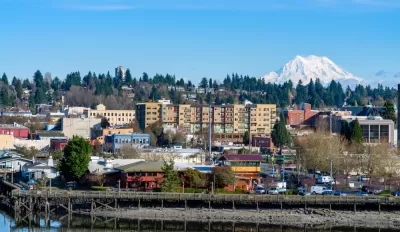The Olympia, Washington City Council adopted a new Housing Options Code Amendments ordinance, effectively eliminating single-family zoning in the city.

The Olympia City Council made planning history as the latest local jurisdiction to adopt a package of zoning reforms to "allow denser housing types in the city’s single-family zoned neighborhoods," reports Brandon Block.
The Housing Options Code Amendments ordinance approved unanimously by the City Council this week "effectively eliminating single-family zoning throughout much of the city."
The ordinance applies to zoning districts R 4-8 (Residential 4-8 units per acre) and R 6-12 (Residential 6-12 units per acre), which collectively account for 68 percent of the city and its urban growth area.
"As The Olympian reported in November, the ordinance legalizes duplexes, triplexes, and fourplexes in R 4-8, as well as triplexes, fourplexes, sixplexes, and courtyard apartments in R 6-12, commonly known as the “duplex zone” (because it already allows duplexes). The height of all of those building types is capped at two stories. It also removes or loosens parking, size, and height, and owner-occupancy restrictions on Accessory Dwelling Units," adds Block for additional detail.
The state Growth Management Hearings Board rejected a previous attempt by the city to legalize Missing Middle Housing construction.
Olympia's new zoning reforms take advantage of a state law, HB 1923, passed in 2019 to exempt "specific zoning code reforms that encourage the construction of additional housing are not subject to [Washington State Environmental Policy Act] appeal."
Update: Stephen Fesler provides in-depth analysis of Olympia's new zoning changes for The Urbanist.
FULL STORY: Olympia City Council passes comprehensive zoning reform ordinance

Alabama: Trump Terminates Settlements for Black Communities Harmed By Raw Sewage
Trump deemed the landmark civil rights agreement “illegal DEI and environmental justice policy.”

Study: Maui’s Plan to Convert Vacation Rentals to Long-Term Housing Could Cause Nearly $1 Billion Economic Loss
The plan would reduce visitor accommodation by 25% resulting in 1,900 jobs lost.

Why Should We Subsidize Public Transportation?
Many public transit agencies face financial stress due to rising costs, declining fare revenue, and declining subsidies. Transit advocates must provide a strong business case for increasing public transit funding.

Wind Energy on the Rise Despite Federal Policy Reversal
The Trump administration is revoking federal support for renewable energy, but demand for new projects continues unabated.

Passengers Flock to Caltrain After Electrification
The new electric trains are running faster and more reliably, leading to strong ridership growth on the Bay Area rail system.

Texas Churches Rally Behind ‘Yes in God’s Back Yard’ Legislation
Religious leaders want the state to reduce zoning regulations to streamline leasing church-owned land to housing developers.
Urban Design for Planners 1: Software Tools
This six-course series explores essential urban design concepts using open source software and equips planners with the tools they need to participate fully in the urban design process.
Planning for Universal Design
Learn the tools for implementing Universal Design in planning regulations.
Caltrans
Smith Gee Studio
Institute for Housing and Urban Development Studies (IHS)
City of Grandview
Harvard GSD Executive Education
Toledo-Lucas County Plan Commissions
Salt Lake City
NYU Wagner Graduate School of Public Service





























